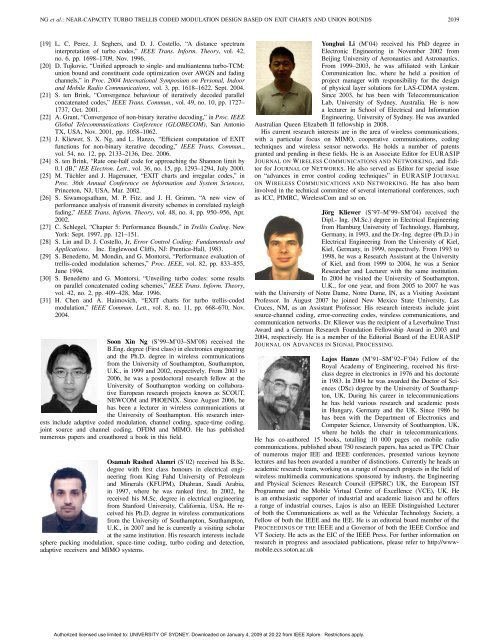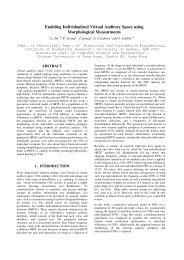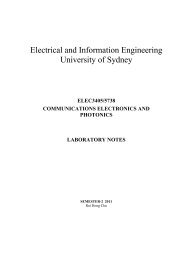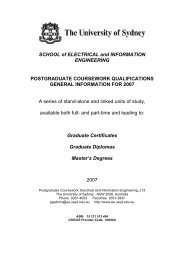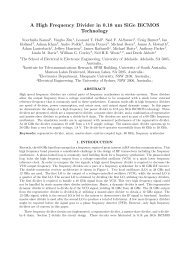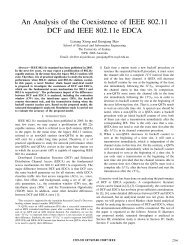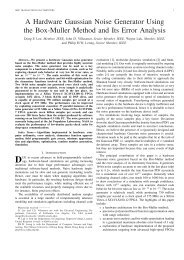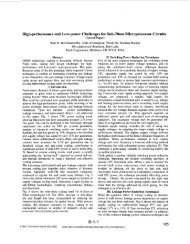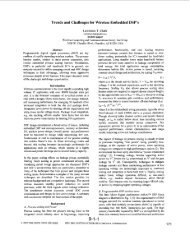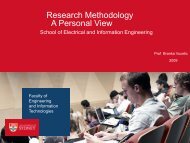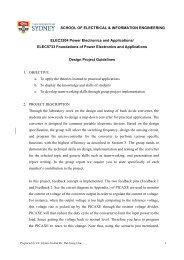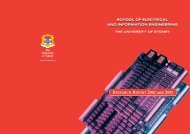Near-capacity turbo trellis coded modulation design based on union ...
Near-capacity turbo trellis coded modulation design based on union ...
Near-capacity turbo trellis coded modulation design based on union ...
You also want an ePaper? Increase the reach of your titles
YUMPU automatically turns print PDFs into web optimized ePapers that Google loves.
NG et al.: NEAR-CAPACITY TURBO TRELLIS CODED MODULATION DESIGN BASED ON EXIT CHARTS AND UNION BOUNDS 2039<br />
[19] L. C. Perez, J. Seghers, and D. J. Costello, “A distance spectrum<br />
interpretati<strong>on</strong> of <str<strong>on</strong>g>turbo</str<strong>on</strong>g> codes,” IEEE Trans. Inform. Theory, vol. 42,<br />
no. 6, pp. 1698–1709, Nov. 1996.<br />
[20] D. Tujkovic, “Unified approach to single- and multiantenna <str<strong>on</strong>g>turbo</str<strong>on</strong>g>-TCM:<br />
uni<strong>on</strong> bound and c<strong>on</strong>stituent code optimizati<strong>on</strong> over AWGN and fading<br />
channels,” in Proc. 2004 Internati<strong>on</strong>al Symposium <strong>on</strong> Pers<strong>on</strong>al, Indoor<br />
and Mobile Radio Communicati<strong>on</strong>s, vol. 3, pp. 1618–1622, Sept. 2004.<br />
[21] S. ten Brink, “C<strong>on</strong>vergence behaviour of iteratively de<str<strong>on</strong>g>coded</str<strong>on</strong>g> parallel<br />
c<strong>on</strong>catenated codes,” IEEE Trans. Commun., vol. 49, no. 10, pp. 1727–<br />
1737, Oct. 2001.<br />
[22] A. Grant, “C<strong>on</strong>vergence of n<strong>on</strong>-binary iterative decoding,” in Proc. IEEE<br />
Global Telecommunicati<strong>on</strong>s C<strong>on</strong>ference (GLOBECOM), San Ant<strong>on</strong>io<br />
TX, USA, Nov. 2001, pp. 1058–1062.<br />
[23] J. Kliewer, S. X. Ng, and L. Hanzo, “Efficient computati<strong>on</strong> of EXIT<br />
functi<strong>on</strong>s for n<strong>on</strong>-binary iterative decoding,” IEEE Trans. Commun.,<br />
vol. 54, no. 12, pp. 2133–2136, Dec. 2006.<br />
[24] S. ten Brink, “Rate <strong>on</strong>e-half code for approaching the Shann<strong>on</strong> limit by<br />
0.1 dB,” IEE Electr<strong>on</strong>. Lett., vol. 36, no. 15, pp. 1293–1294, July 2000.<br />
[25] M. Tüchler and J. Hagenauer, “EXIT charts and irregular codes,” in<br />
Proc. 36th Annual C<strong>on</strong>ference <strong>on</strong> Informati<strong>on</strong> and System Sciences,<br />
Princet<strong>on</strong>, NJ, USA, Mar. 2002.<br />
[26] S. Siwamogsatham, M. P. Fitz, and J. H. Grimm, “A new view of<br />
performance analysis of transmit diversity schemes in correlated rayleigh<br />
fading,” IEEE Trans. Inform. Theory, vol. 48, no. 4, pp. 950–956, Apr.<br />
2002.<br />
[27] C. Schlegel, “Chapter 5: Performance Bounds,” in Trellis Coding. New<br />
York: Sept. 1997, pp. 121–151.<br />
[28] S. Lin and D. J. Costello, Jr, Error C<strong>on</strong>trol Coding: Fundamentals and<br />
Applicati<strong>on</strong>s. Inc. Englewood Cliffs, NJ: Prentice-Hall, 1983.<br />
[29] S. Benedetto, M. M<strong>on</strong>din, and G. M<strong>on</strong>torsi, “Performance evaluati<strong>on</strong> of<br />
<str<strong>on</strong>g>trellis</str<strong>on</strong>g>-<str<strong>on</strong>g>coded</str<strong>on</strong>g> <str<strong>on</strong>g>modulati<strong>on</strong></str<strong>on</strong>g> schemes,” Proc. IEEE, vol. 82, pp. 833–855,<br />
June 1994.<br />
[30] S. Benedetto and G. M<strong>on</strong>torsi, “Unveiling <str<strong>on</strong>g>turbo</str<strong>on</strong>g> codes: some results<br />
<strong>on</strong> parallel c<strong>on</strong>catenated coding schemes,” IEEE Trans. Inform. Theory,<br />
vol. 42, no. 2, pp. 409–428, Mar. 1996.<br />
[31] H. Chen and A. Haimovich, “EXIT charts for <str<strong>on</strong>g>turbo</str<strong>on</strong>g> <str<strong>on</strong>g>trellis</str<strong>on</strong>g>-<str<strong>on</strong>g>coded</str<strong>on</strong>g><br />
<str<strong>on</strong>g>modulati<strong>on</strong></str<strong>on</strong>g>,” IEEE Commun. Lett., vol. 8, no. 11, pp. 668–670, Nov.<br />
2004.<br />
So<strong>on</strong> Xin Ng (S’99–M’03–SM’08) received the<br />
B.Eng. degree (First class) in electr<strong>on</strong>ics engineering<br />
and the Ph.D. degree in wireless communicati<strong>on</strong>s<br />
from the University of Southampt<strong>on</strong>, Southampt<strong>on</strong>,<br />
U.K., in 1999 and 2002, respectively. From 2003 to<br />
2006, he was a postdoctoral research fellow at the<br />
University of Southampt<strong>on</strong> working <strong>on</strong> collaborative<br />
European research projects known as SCOUT,<br />
NEWCOM and PHOENIX. Since August 2006, he<br />
has been a lecturer in wireless communicati<strong>on</strong>s at<br />
the University of Southampt<strong>on</strong>. His research interests<br />
include adaptive <str<strong>on</strong>g>coded</str<strong>on</strong>g> <str<strong>on</strong>g>modulati<strong>on</strong></str<strong>on</strong>g>, channel coding, space-time coding,<br />
joint source and channel coding, OFDM and MIMO. He has published<br />
numerous papers and coauthored a book in this field.<br />
Osamah Rashed Alamri (S’02) received his B.Sc.<br />
degree with first class h<strong>on</strong>ours in electrical engineering<br />
from King Fahd University of Petroleum<br />
and Minerals (KFUPM), Dhahran, Saudi Arabia,<br />
in 1997, where he was ranked first. In 2002, he<br />
received his M.Sc. degree in electrical engineering<br />
from Stanford University, California, USA. He received<br />
his Ph.D. degree in wireless communicati<strong>on</strong>s<br />
from the University of Southampt<strong>on</strong>, Southampt<strong>on</strong>,<br />
U.K., in 2007 and he is currently a visiting scholar<br />
at the same instituti<strong>on</strong>. His research interests include<br />
sphere packing <str<strong>on</strong>g>modulati<strong>on</strong></str<strong>on</strong>g>, space-time coding, <str<strong>on</strong>g>turbo</str<strong>on</strong>g> coding and detecti<strong>on</strong>,<br />
adaptive receivers and MIMO systems.<br />
Y<strong>on</strong>ghui Li (M’04) received his PhD degree in<br />
Electr<strong>on</strong>ic Engineering in November 2002 from<br />
Beijing University of Aer<strong>on</strong>autics and Astr<strong>on</strong>autics.<br />
From 1999–2003, he was affiliated with Linkair<br />
Communicati<strong>on</strong> Inc, where he held a positi<strong>on</strong> of<br />
project manager with resp<strong>on</strong>sibility for the <str<strong>on</strong>g>design</str<strong>on</strong>g><br />
of physical layer soluti<strong>on</strong>s for LAS-CDMA system.<br />
Since 2003, he has been with Telecommunicati<strong>on</strong><br />
Lab, University of Sydney, Australia. He is now<br />
a lecturer in School of Electrical and Informati<strong>on</strong><br />
Engineering, University of Sydney. He was awarded<br />
Australian Queen Elizabeth II fellowship in 2008.<br />
His current research interests are in the area of wireless communicati<strong>on</strong>s,<br />
with a particular focus <strong>on</strong> MIMO, cooperative communicati<strong>on</strong>s, coding<br />
techniques and wireless sensor networks. He holds a number of patents<br />
granted and pending in these fields. He is an Associate Editor for EURASIP<br />
JOURNAL ON WIRELESS COMMUNICATIONS AND NETWORKING, andEditor<br />
for JOURNAL OF NETWORKS. He also served as Editor for special issue<br />
<strong>on</strong> “advances in error c<strong>on</strong>trol coding techniques” in EURASIP JOURNAL<br />
ON WIRELESS COMMUNICATIONS AND NETWORKING. He has also been<br />
involved in the technical committee of several internati<strong>on</strong>al c<strong>on</strong>ferences, such<br />
as ICC, PIMRC, WirelessCom and so <strong>on</strong>.<br />
Jörg Kliewer (S’97–M’99–SM’04) received the<br />
Dipl.- Ing. (M.Sc.) degree in Electrical Engineering<br />
from Hamburg University of Technology, Hamburg,<br />
Germany, in 1993, and the Dr.-Ing. degree (Ph.D.) in<br />
Electrical Engineering from the University of Kiel,<br />
Kiel, Germany, in 1999, respectively. From 1993 to<br />
1998, he was a Research Assistant at the University<br />
of Kiel, and from 1999 to 2004, he was a Senior<br />
Researcher and Lecturer with the same instituti<strong>on</strong>.<br />
In 2004 he visited the University of Southampt<strong>on</strong>,<br />
U.K., for <strong>on</strong>e year, and from 2005 to 2007 he was<br />
with the University of Notre Dame, Notre Dame, IN, as a Visiting Assistant<br />
Professor. In August 2007 he joined New Mexico State University, Las<br />
Cruces, NM, as an Assistant Professor. His research interests include joint<br />
source-channel coding, error-correcting codes, wireless communicati<strong>on</strong>s, and<br />
communicati<strong>on</strong> networks. Dr. Kliewer was the recipient of a Leverhulme Trust<br />
Award and a German Research Foundati<strong>on</strong> Fellowship Award in 2003 and<br />
2004, respectively. He is a member of the Editorial Board of the EURASIP<br />
JOURNAL ON ADVANCES IN SIGNAL PROCESSING.<br />
Lajos Hanzo (M’91–SM’92–F’04) Fellow of the<br />
Royal Academy of Engineering, received his firstclass<br />
degree in electr<strong>on</strong>ics in 1976 and his doctorate<br />
in 1983. In 2004 he was awarded the Doctor of Sciences<br />
(DSc) degree by the University of Southampt<strong>on</strong>,<br />
UK. During his career in telecommunicati<strong>on</strong>s<br />
he has held various research and academic posts<br />
in Hungary, Germany and the UK. Since 1986 he<br />
has been with the Department of Electr<strong>on</strong>ics and<br />
Computer Science, University of Southampt<strong>on</strong>, UK,<br />
where he holds the chair in telecommunicati<strong>on</strong>s.<br />
He has co-authored 15 books, totalling 10 000 pages <strong>on</strong> mobile radio<br />
communicati<strong>on</strong>s, published about 750 research papers, has acted as TPC Chair<br />
of numerous major IEE and IEEE c<strong>on</strong>ferences, presented various keynote<br />
lectures and has been awarded a number of distincti<strong>on</strong>s. Currently he heads an<br />
academic research team, working <strong>on</strong> a range of research projects in the field of<br />
wireless multimedia communicati<strong>on</strong>s sp<strong>on</strong>sored by industry, the Engineering<br />
and Physical Sciences Research Council (EPSRC) UK, the European IST<br />
Programme and the Mobile Virtual Centre of Excellence (VCE), UK. He<br />
is an enthusiastic supporter of industrial and academic liais<strong>on</strong> and he offers<br />
a range of industrial courses. Lajos is also an IEEE Distinguished Lecturer<br />
of both the Communicati<strong>on</strong>s as well as the Vehicular Technology Society, a<br />
Fellow of both the IEEE and the IEE. He is an editorial board member of the<br />
PROCEEDINGS OF THE IEEE and a Governor of both the IEEE ComSoc and<br />
VT Society. He acts as the EIC of the IEEE Press. For further informati<strong>on</strong> <strong>on</strong><br />
research in progress and associated publicati<strong>on</strong>s, please refer to http://wwwmobile.ecs.sot<strong>on</strong>.ac.uk<br />
Authorized licensed use limited to: UNIVERSITY OF SYDNEY. Downloaded <strong>on</strong> January 4, 2009 at 20:22 from IEEE Xplore. Restricti<strong>on</strong>s apply.


